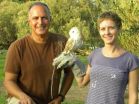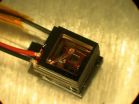(Press-News.org) CHAPEL HILL, NC – A collaboration between physicians and scientists at UNC Lineberger Comprehensive Cancer Center and the University of Texas M.D. Anderson Cancer Center has demonstrated that a biomarker called TCF21 may be used to develop a potential screening test for early-stage lung cancer.
Despite the fact that lung cancer is the leading cause of cancer deaths worldwide, early-stage lung cancer is difficult to diagnose. A number of proposed screening tests, including screening CT scans and serum markers, have not shown any benefit in enhancing patient survival.
TCF21 is a transcription factor – a protein that binds to DNA, allowing it to reproduce itself accurately, allowing cells to multiply and replace themselves in a consistent manner. When these transcription factors don't work properly (through a process called hypermethylation), cellular growth mechanisms can be disrupted, leading to cancer.
"We were very excited to find evidence of TCF21 hypermethylation in 105 non-small-cell lung cancers of different stages and types, which we then validated by looking at another 300 cases using a tissue microarray," said Kristy Richards, PhD,MD, who led the research.
"More than 80 percent of these cancers show some abnormal expression of this biomarker, meaning that it is a promising target for developing a screening tool. This is important to physicians and patients because surgery and other treatments can be much more effective before the cancer has the opportunity to spread."
###
The research results were published in the journal Cancer.
Research team members from UNC Lineberger include D. Neil Hayes, MD, MPH. Researchers at M.D. Anderson include corresponding author Ralf Krahe, PhD, Ignacio Wistuba, MD, Guosheng Yin, PhD, Keith Baggerly, PhD, Charmaine Wilson, MD, Lisa Bachinski PhD, Jennifer Churchill, BS, Wenli Dong, PhD, Menghong Sun, PhD, and Baili Zhang, MS.
END
Only one-fifth of primary care physicians in the US follow practice guidelines for colorectal cancer screening for all the tests they recommend, according to Dr. Robin Yabroff from the National Cancer Institute and her colleagues. About 40 percent followed guidelines for some of the tests they recommended and the remaining 40 percent did not follow guidelines for any of the screening tests they recommended. Furthermore, their analysis1 of physician screening recommendations for colorectal cancer shows that many clinicians either overuse or underuse screening. Their findings ...
Even Darwin was a self-admitted orchid lover. Dictionaries describe orchids as exotic ornamentals. Indeed, these plants – more than 30000 different species are thought to exist – are exotic due their extraordinary and diverse flower morphology. However, they are also exotic from a point of view other than beauty: as crafty imposters in order to achieve reproduction and to make sure that their ovaries are pollinated. Orchids depend on the assistance of pollinators, and like many other flowering plants, attract insects.
Epipactis veratrifolia, an orchid native in South ...
WASHINGTON – Children whose mothers return to work before their offspring turn 3 are no more likely to have academic or behavioral problems than kids whose mothers stay at home, according to a review of 50 years of research.
"Overall, I think this shows women who go back to work soon after they have their children should not be too concerned about the effects their employment has on their children's long-term well-being," said psychologist Rachel Lucas-Thompson, PhD, lead author of the study conducted with Drs. JoAnn Prause and Wendy Goldberg at the University of California, ...
COLUMBUS, Ohio – People who believe false rumors about the proposed Islamic cultural center and mosque near Ground Zero in New York City not only are more likely to oppose that project – they are more likely to oppose building of a mosque in their own neighborhood.
Researchers surveyed 750 Americans and asked them if they believed any of four rumors associated with the New York City mosque, all of which have been refuted. One of the rumors, for example, falsely says that that the proposed center is scheduled to open on September 11, 2011 in celebration of the 10-year ...
New Haven, Conn.—Sixty-three percent of Americans believe that global warming is happening, but many do not understand why, according to a national study conducted by researchers at Yale University.
The report titled "Americans' Knowledge of Climate Change" found that only 57 percent know what the greenhouse effect is, only 45 percent of Americans understand that carbon dioxide traps heat from the Earth's surface, and just 50 percent understand that global warming is caused mostly by human activities. Large majorities incorrectly think that the hole in the ozone layer ...
Scientists at JILA and collaborators have demonstrated an improved laser-based "molecular fingerprinting" technique that picks out traces of key hydrogen-containing and other molecules from a billion other particles in a gas in just 30 seconds or less—performance suitable for breathalyzers for diagnosing disease, measuring trace gases in the atmosphere, detecting security threats and other applications.
JILA is jointly operated by the National Institute of Standards and Technology (NIST) and University of Colorado at Boulder (CU).
Described in Optics Express,* the research ...
PHILADELPHIA — An article published in the Ffall 2010 issue of CR, the AACR's magazine for cancer survivors and their families and caregivers, details the immense challenges faced by those who suffer with cancer and lack the necessary resources for proper treatment and care — the homeless.
CR magazine contributing writer Cynthia Ryan, Ph.D., who is an associate professor of English at the University of Alabama at Birmingham, took to the streets over the last year to offer a glimpse into the lives of homeless cancer patients struggling to obtain treatment while being ...
BUFFALO, N.Y. -- Cyber attacks of various sorts have been around for decades. The most recent, and very dangerous, escalation in the past few years has been marked by countries launching attacks against other nations, such as Stuxnet, the nuclear plant-disrupting worm the Iranians have blamed on Israel and the U.S., while others are pointing the finger at Russia.
University at Buffalo military ethicist Randall R. Dipert, PhD, one of the founders of the National Center for Ontological Research at UB, says we have good reason to worry, because cyber attacks are almost ...
Anxiety, or the reaction to a perceived danger, is a response that differs from one animal or human to another ― or so scientists thought. Now researchers at Tel Aviv University are challenging what we know about stress, and their study has implications for helping clinicians better treat victims of terrorism or natural disasters.
Prof. David Eilam and his graduate student Rony Izhar of Tel Aviv University's Department of Zoology are spearheading a study designed to investigate the anxieties experienced by an entire social group. Using the natural predator-and-prey ...
Researchers from the National Institute of Standards and Technology (NIST) and the German national metrology institute have used NIST's miniature atom-based magnetic sensor to successfully track a human heartbeat, confirming the device's potential for biomedical applications.
Described in Applied Physics Letters,* the study is the first to be performed under conditions resembling a clinical setting with the NIST mini-sensors, which until now have been operated mostly in physics laboratories. The new experiments were carried out at the Physikalisch Technische Bundesanstalt ...



